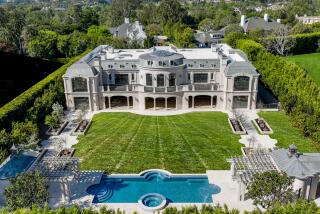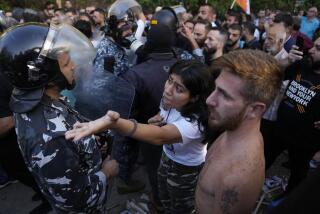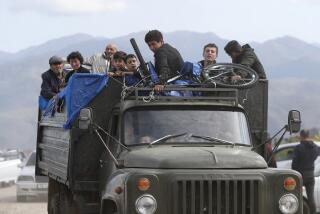Armenian Patriarch’s U.S. Visit Stresses Unity
The bearded patriarch from Beirut was on a U.S. tour of Armenian Orthodox churches two years ago--visiting only parishes aligned with his branch of the divided church--when the Northridge earthquake hit, shaking him out of bed at the Universal Hilton Hotel.
Two days later, as he visited parishes to survey the damage, Karekin II made a small gesture with grand significance. He stopped not only at parishes aligned with his Lebanon-based branch of the church, but visited St. Peter Armenian Church in Van Nuys, a congregation loyal to the other branch of Armenian Christianity.
It was an unusual gesture of reconciliation--and foreshadowed the future.
The same patriarch--or Catholicos, the equivalent of the Pope in the Roman Catholic Church--returned Thursday to Los Angeles, where he continued his efforts to reunite the two factions of the church, divided for more than 60 years by Cold War politics.
The Los Angeles area has an estimated 350,000 residents of Armenian heritage, many of whom belong to the branch headed by the mother church in Etchmaidzin, Armenia. Others identify with the branch based in Lebanon, which split off 60 years ago because Etchmaidzin was in the part of Armenia--now independent--then under Soviet rule.
After 18 years as head of the Lebanon-based church, the Oxford-educated patriarch was elected in April as the Catholicos of All Armenians and the leader of the mother church in Etchmaidzin, drawing closer the two branches. When he assumed the new position, he took the name Karekin I because the Armenia-based church had no previous Catholicos of that name.
Since beginning his United States tour last month, Karekin I has emphasized at every stop that in spiritual terms there is only one church.
Karekin I said unity talks have begun on the East Coast and now, on his first visit to Los Angeles as Catholicos, “I have seen much closer associations and a rapprochement between the two administrative units,” compared with his visit two years ago.
On that visit, he surprised onlookers by venturing beyond his official responsibility as head of the Lebanon-based church to offer his help to other Armenian parishes damaged by the quake.
“He ignored, let’s say, jurisdictional boundaries and walked through the rubble in the sanctuary, carefully stepping over the pieces of stained glass, got close to the altar and then said, ‘Let’s pray,’ ” recalled Father Shnork Demirjian, pastor of St. Peter’s in Van Nuys.
*
“At that time, I wasn’t thinking about the schism of the church, which is based only on political reasons, because I was feeling the presence of the Holy Spirit,” Demirjian said. “I still feel that only through prayer and the Holy Spirit can this division be healed.”
Karekin I’s six days in Southern California will include visits with Mayor Richard Riordan and the Los Angeles City Council, a banquet in Century City tonight, and the celebration of the Divine Liturgy at 10 a.m. Sunday at the partially repaired and renovated St. Peter’s.
Upon his arrival Thursday, Karekin I told the nearly 400 people gathered at St. John’s Armenian Church of his hope for cultural and political unity among Armenians in the new, independent republic of Armenia.
“Our ancestors closed their eyes to dream the life we are now living,” said the 63-year-old black-robed monk, scholar and teacher.
However, the patriarch declined to comment to reporters on the volatile political situation in Armenia. The country’s leading opposition party, the Dashnak, has been outlawed by Armenia’s President Levon Der-Petrossian, and critics have decried the action as undemocratic.
“This is not an issue for the church,” he said. “It is for the courts to decide.”
Outside St. John’s church on Vine Street, two limousines, four police cars and several plainclothes security officers waited. Although terrorist attacks between Armenians and Turks have eased in the last few years, security was still tight.
In Southern California’s large Armenian community, not all Christians owe spiritual allegiance to the patriarch. Some Armenian-heritage Christians belong to Episcopal, Catholic, Methodist or mainline congregations with no particular ethnic identity. And some attend other ethnic churches, such as the United Armenian Congregational Church in the Cahuenga Pass or the Armenian Church of the Nazarene in Glendale.
But among Armenian Orthodox churches, grass-roots cooperation between the two jurisdictions “is getting better all the time,” said Glendale attorney Arsen Danielian, vice chairman of the regional executive council of the Lebanon-based branch.
Administration of the Armenian church in America has been divided since 1933, when a split developed over the status of the church in Soviet Armenia. The Armenian Apostolic Church, fearing communist infiltration, chose to ally itself with the Catholicate of Cilicia in Lebanon rather than with the Patriarchate in Armenia. The Armenian Church of America, the church’s original U.S. diocese, founded in 1892, remained loyal to the Patriarchate in Armenia.
A “unity commission” is working to bring together the two jurisdictions, both of which are based in New York. There are an estimated 1 million Armenian Christians in the United States.
Karekin I, who was born in Syria and baptized Neshan Sarkissianas, served as primate of the Armenian Apostolic Church in America from 1974 to 1977.
Christopher Zakian, public relations director for the other branch, the Armenian Church of America, said, “A lot of the division goes back to my great-grandfather’s and grandfather’s time. It really doesn’t matter now.”
More to Read
Sign up for Essential California
The most important California stories and recommendations in your inbox every morning.
You may occasionally receive promotional content from the Los Angeles Times.










